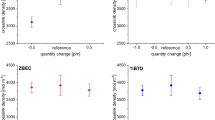Abstract
The objective of this work was to study the elastic recovery of EPDM samples crosslinked either by a phenolic resin (resol) or by a radical peroxide (dicumyl peroxide, DCP). From compression set experiments, it was observed that radically crosslinked EPDMs have better elastic recovery properties. On the other hand, for the same crosslinking density, radically crosslinked EPDM shows better compression set than EPDM crosslinked with phenolic resins. The Chasset-Thirion equation was then used to successfully fit the experimental relaxation curves. As a notable result, the preferential statistics of a peroxide-crosslinked network over a phenolic resin (resol) showed that better elastic recovery properties were obtained. Finally, the influence of fillers (carbon black and silica) was also studied. Carbon black with DCP crosslinking was shown to improve elasticity recovery whereas silica fillers lead to worse properties. It was then assumed that the interaction between particle surface and a voir comme dans autre publi à modifier ce crosslinking agent induced crosslinking gradients in the inter-particle volume.

Graphical abstract








Similar content being viewed by others
References
Akbar S, Beyou E, Cassagnau P, Chaumont P (2009) Radical grafting of polyethylene onto MWCNTs : a model compound approach. Polymer 50(12):2535–2543
Chasset R, Thirion P (1965) Proceedings of the Conference on Physics of Non-Crystalline Solids
Curro JG, Pearson DS, Helfand E (1985) Viscoelasticity of randomly cross-linked polymer networks. Relaxation of dangling chains. Macromolecules 18:1157–1162
Dossin LM, Graessley WW (1979) Rubber elasticity of well-characterized polybutadien rubber. Macromolecules 12:123–130
Ferry JD (1980) Viscoelastic properties of polymers, 3rd Ed
Garcia B, Ruben D, Keromnes L, Goutille Y, Cassagnau P, Fenouillot F, Chaumont P (2014) Structural evolution of a constrained epoxy functional polyethylene network crosslinked by a bio-based reactant. Eur Polym J 61:186–196
Joubert C, Michel A, Choplin L, Cassagnau P (2003) Influence of the crosslink network structure on stress- relaxation behavior : viscoelastic modeling of the compression set experiment. Polymer 41:1779–1790
Langley NR (1968) Elastically effective strand density in polymer networks. Macromolecules 1(4):348–352
Martin G, Barrès C, Cassagnau P, Sonntag P, Garois N (2008) Viscoelasticity of randomly crosslinked EPDM networks. Polymer 49:1892–1901
Ning N, Li S, Wu H, Tian H, Yao P, Hu G-H, Tian M, Zhang L (2018) Preparation, microstructure, and microstructure-properties relationship of thermoplastic vulcanizates (TPVs): a review. Prog Polym Sci 79:61–97
Orza RA (2008) Investigation of peroxide crosslinking of EPDM rubber by solid-state NMR. Technische Universiteit Eindhoven
Orza RA, Magusin PCM, Litvinov VM, Van Duin M, Michels MAJ (2005) Network density and diene conversion in peroxide-cured gumstock epdm rubbers . a solid-state nmr study. Macromol Symp 230:144–148
Palmas P, Le Campion L, Bourgeoisat C, Martel L (2001) Curing and thermal ageing of elastomers as studied by 1H broadband and 13C high-resolution solid-state NMR. Polymer 42:7675–7683
Pincus P, Curro JG (1983) A theoretical basis for viscoelastic relaxation of elastomers in the long-time limit. Macromolecules 16:559–562
Van Duin M (2000) The chemistry of phenol-formaldehyde resin crosslinking of EPDM as studied with low molecular-weight models: part II. Formation of inert species, crosslinking precursors and crosslinks. Rubber Chem Technol 73:706–719
Van Duin M (2002) Chemistry of EPDM cross-linking. Kautsch Gummi Kunst 55:150–150
Zaborski M, Donnet JB (2003) Activity of fillers in elastomer networks of different structure. Macromol Symp 194:87–99
Author information
Authors and Affiliations
Corresponding author
Additional information
Publisher’s note
Springer Nature remains neutral with regard to jurisdictional claims in published maps and institutional affiliations.
Electronic supplementary material
ESM 1
(DOCX 95 kb)
Rights and permissions
About this article
Cite this article
Le Hel, C., Bounor-Legaré, V., Lucas, A. et al. Elasticity recovery of crosslinked EPDM: influence of the chemistry and nanofillers. Rheol Acta 60, 1–10 (2021). https://doi.org/10.1007/s00397-020-01246-0
Received:
Revised:
Accepted:
Published:
Issue Date:
DOI: https://doi.org/10.1007/s00397-020-01246-0




